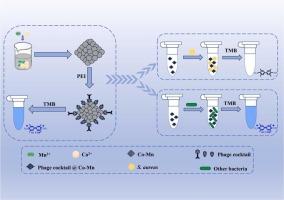利用噬菌体鸡尾酒快速、灵敏、广谱比色法检测食品中活菌金黄色葡萄球菌
IF 3.7
1区 化学
Q1 CHEMISTRY, ANALYTICAL
引用次数: 0
摘要
虽然噬菌体(噬菌体)是用于金黄色葡萄球菌检测的理想生物识别元件,但现有的基于单噬菌体的方法受到噬菌体特异性亲和力和假阴性结果的限制。为了建立一种基于噬菌体的比色检测系统并研究其检测机制,我们制备了一种由三种金黄色葡萄球菌噬菌体(SapYZU10、SapYZU11和SapYZUM13)组成的噬菌体鸡尾酒,将其固定在Co-Mn纳米酶上,并应用于金黄色葡萄球菌进行评价。噬菌体cocktail@Co-Mn在大约17 min内对金黄色葡萄球菌活菌计数进行了灵敏、特异和快速的比色评估,检出限为92 CFU/mL。此外,噬菌体cocktail@Co-Mn成功地用于检测食品样品中的金黄色葡萄球菌,回收率为92.21 % ~ 105.56 %。噬菌体cocktail@Co-Mn也表现出对pH(3-9)、5种食品添加剂和NaCl浓度(2 % -10 %)变化的弹性。噬菌体cocktail@Co-Mn的检测机制包括阻断产生O2•-的纳米酶的活性位点。值得注意的是,由于鸡尾酒中三个噬菌体的协同识别光谱,菌株的识别率达到了100 %,而单个噬菌体的识别率要低得多(在74.7 %至76.9 %之间)。识别机制涉及噬菌体尾部纤维与金黄色葡萄球菌宿主之间的吸附。这项开创性的研究揭示了噬菌体鸡尾酒是一种有效的生物识别元件,适用于食品工业中活菌金黄色葡萄球菌的快速、灵敏、特异、可靠和比色检测,为基于噬菌体的检测方法提供了创新方向。本文章由计算机程序翻译,如有差异,请以英文原文为准。

Rapid, sensitive and wide-spectrum colourimetric detection of viable Staphylococcus aureus in food using phage cocktail
Although bacteriophages (phages) are ideal biorecognition elements employed for Staphylococcus aureus detection, existing single-phage-based approaches are limited by the specific affinity of phages and false-negative results. To develop an improved phage-based colourimetric detection system and investigate its detection mechanism, we prepared a phage cocktail composed of three S. aureus phages (SapYZU10, SapYZU11, and SapYZUM13), immobilised it on Co-Mn nanozymes, and applied it to S. aureus for evaluation. The phage cocktail@Co-Mn demonstrated a sensitive, specific, and fast colourimetric evaluation of live S. aureus counts in approximately 17 min, with a detection limit of 92 CFU/mL. Moreover, the phage cocktail@Co-Mn was successfully used to detect S. aureus in food samples, with recovery rates ranging from 92.21 % to 105.56 %. The phage cocktail@Co-Mn also exhibited resilience to changes in pH (3–9), five food additives, and NaCl concentration (2 %–10 %). The detection mechanism of the phage cocktail@Co-Mn involves blockage of the active sites of the nanozyme producing O2•–. Notably, owing to the synergistic recognition spectra of the three phages in the cocktail, the recognition rate for the strains was a remarkable 100 %, compared with the much lower recognition rates of individual phages (between 74.7 % and 76.9 %). The recognition mechanism involves adsorption between phage tail fibres and S. aureus hosts. This pioneering study revealed that the phage cocktail is an effective biorecognition element suitable for the rapid, sensitive, specific, reliable, and colourimetric detection of viable S. aureus strains in the food industry, providing innovative directions for the phage-based detection methods.
求助全文
通过发布文献求助,成功后即可免费获取论文全文。
去求助
来源期刊

Sensors and Actuators B: Chemical
工程技术-电化学
CiteScore
14.60
自引率
11.90%
发文量
1776
审稿时长
3.2 months
期刊介绍:
Sensors & Actuators, B: Chemical is an international journal focused on the research and development of chemical transducers. It covers chemical sensors and biosensors, chemical actuators, and analytical microsystems. The journal is interdisciplinary, aiming to publish original works showcasing substantial advancements beyond the current state of the art in these fields, with practical applicability to solving meaningful analytical problems. Review articles are accepted by invitation from an Editor of the journal.
 求助内容:
求助内容: 应助结果提醒方式:
应助结果提醒方式:


